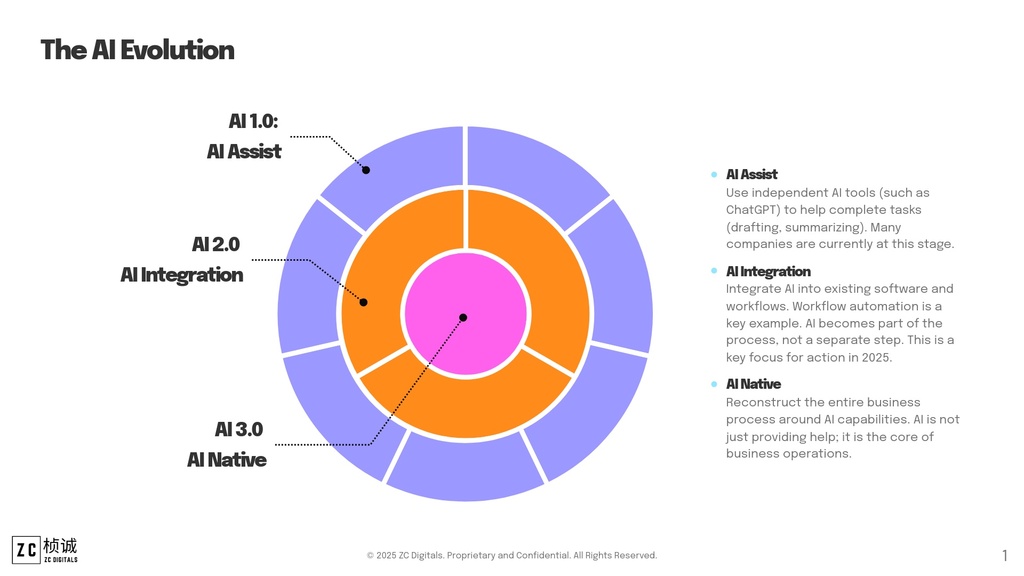It feels like AI exploded onto the scene overnight, right? But if you look closer, especially over the last couple of years since tools like ChatGPT became household names, you can see a clear evolution happening. It’s not just one big AI wave; it’s unfolding in distinct stages. Understanding these stages helps make sense of where we’ve been, where we are now, and where we’re heading.
Let’s break down the three key stages:
Stage 1: AI Assist (AI 1.0) – The Helpful Toolbox 🛠️
This is where most of us started, and where many still operate. Think of the explosion of individual AI tools:
- LLMs (like ChatGPT): For drafting emails, writing copy, summarizing text.
- Image Generators (like Midjourney, Stable Diffusion): For creating visuals.
- Transcription Tools: For turning audio/video into text.
- Text-to-Speech Tools: For generating audio.
In the AI Assist stage, we use these tools like assistants. We have a task (e.g., write an email), we go out to the specific AI tool (copy/paste prompts into ChatGPT), get the output, and then copy/paste it back into our existing workflow (our email client).
The key here is that the AI tools are separate from our main workflow. They assist us, but we’re the ones manually bridging the gap, copying and pasting, and stitching things together. It’s helpful, absolutely, but still requires significant manual effort. This has largely defined the AI landscape for the past couple of years.
Stage 2: AI Integration (AI 2.0) – The Connected Workflow 🔗
This is where things get really interesting, and it’s the stage we’re rapidly moving into now. Instead of going out to use separate AI tools, we’re bringing AI into our existing systems and workflows.
Think about AI being integrated directly into the software you already use, or having access to multiple tools within your operating system or primary platform. This leads to the rise of AI Agents.
Imagine this: You need a proposal presentation. Instead of manually using separate tools, you tell your AI agent: “Create a proposal presentation about Project X.” The agent could then:
- Use an LLM to draft the content and structure.
- Access your PowerPoint (or Google Slides) tool to build the actual slides.
- Connect to an image generation service to create relevant pictures and insert them.
- Maybe even pull relevant data from your files or emails to personalize it.
The end result? A complete, ready-to-review presentation generated from a single request, because the AI is integrated and can orchestrate multiple tools within your workflow. This stage is about streamlining processes and making AI a seamless part of how we work.
Stage 3: AI Native (AI 3.0) – Redesigning Around AI 🌐
This is the future, the ultimate destination (for now!). If AI 2.0 is about integrating AI into existing workflows, AI 3.0 is about redesigning processes and experiences around AI from the ground up.
It’s like the shift from “mobile-friendly” websites (adapting desktop sites for phones) to “mobile-first” design (designing specifically for the mobile experience). In the AI Native stage, AI isn’t just an add-on; it’s the central pillar around which solutions are built.

Let’s take a marketing agency example:
- AI Assist (1.0): Use ChatGPT to help write a few ad variations.
- AI Integration (2.0): Use an AI agent to generate 50 ad variations, create accompanying images, and set up draft campaigns in Google Ads.
- AI Native (3.0): The entire campaign process is AI-centric. The AI generates thousands of ad variations, automatically deploys them across platforms, continuously monitors performance in real-time, analyzes results, and dynamically adjusts bidding, targeting, and creative without significant human intervention. The workflow itself is fundamentally different because it’s built assuming AI handles the core operations.
Where Are We Now? Where Are You Headed?
Most businesses and individuals are currently transitioning from AI Assist (1.0) towards AI Integration (2.0). Building or utilizing AI agents that connect different tools and streamline workflows is the big focus right now.
Thinking ahead, the goal is to move towards AI Native (3.0) solutions where AI fundamentally reshapes how problems are solved and value is created.
Understanding these stages helps you strategize. Are you still just using AI tools? How can you start integrating them more deeply? And what would it look like to rebuild your core processes with AI at the very center? The evolution is happening fast – it pays to think ahead!
